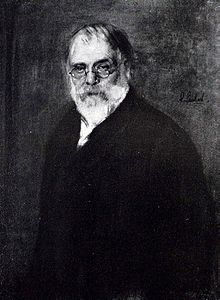Alois Hauser the Elder

Alois Hauser (17 February 1831 – 7 March 1909) was a German art restorer, court painter and curator.
Life
He was born in
Katharinenkloster
, as was the new Staatsgalerie, founded in 1835.
Probably again through Carry's influence, Hauser met
German National Museum
in Nuremberg, founded in 1852. He also carried out restoration for Bamberg's own Kunstinstitut from 1865 onwards as well as being appointed conservator of the city's paintings in 1869.
As a restorer he was part of a new generation which analysed historical painting techniques so as to assess how best to restore the paint surface, as described in his 1896 Anleitung zur Technik der Oelmalerei.The Great Last Judgement and van Dyck's Susanna and the Elders. In 1887 he also restored the Darmstadt Madonna, a campaign recognised with its own exhibition,
Trainees in his conservation studio in Munich went on to work at other major European museums, including his own son Alois Hauser the Younger (1857–1919), who became head restorer at the
Gemäldegalerie (Berlin) in 1887, and Otto Vermehren, later Head of Conservation at the Uffizi in Florence. Hauser the Elder died in Munich in 1909 and was buried in Schwabing, with the funeral oration given by Franz von Reber, director of the Bayerischen Staatssammlungen, stating that Hauser was "not only the best, but the best in his field in his time".[2]
Bibliography (in German)
- Burger, Friedrich Richard: Offener Brief an Herrn Professor Alois Hauser, I. Konservator an der Alten Pinakothek zu München, Munich 1906 (Digital)
- Holland, Hyacinth: Hauser, Alois. In: Biographisches Jahrbuch und Deutscher Nekrolog 14 (1912), pp. 164–167 (Digital)
- Senn, Ernst: Zur Bildkunde Hohenzollern. Fr. von Lenbach: Professor Alois Hauser 1831–1909. In Hohenzollerische Jahreshefte 7 (1940), pp. 110–113
- Mandt, Petra: Alois Hauser d. J. (1857–1919) und sein Manuskript "Über die Restauration von Gemälden". In Zeitschrift für Kunsttechnologie und Konservierung 9 (1995), fascicule 2, pp. 215–231
References
- ^ "Online edition".
- ^ Holland 1912, p. 167
